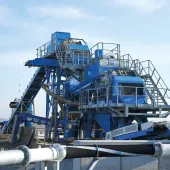CDE washing plant installation for Hereford Quarries

Aggregates firm recycles 100% of inert waste with CDE wet-processing system
PART of Wye Valley Group, one of Herefordshire’s leading recycling operators, Hereford Quarries Ltd are a relatively new company that has moved into a diverse portfolio of business sectors, including demolition, construction, skip hire, muckaway and waste-management.
Based at its 10-acre Lugg Bridge site, north-east of Hereford, the company was established in 2015 with the aim of maximizing local resources to reduce the county’s reliance on imported virgin primary aggregates.
The operation began with a mobile jaw crusher and screen to process construction waste into basic crusher run and hardcore materials, suitable for use as low-grade sub-base material.
‘The rudimentary crusher runs and hardcore products we started with allowed us to recycle inert construction waste materials which, subsequently, helped us in meeting our sustainability objectives by processing material that was destined for landfill,’ said David Ambrose, commercial manager for Hereford Quarries.
‘However, the final product was of the minimum technical standard that could be accepted into the marketplace and, as such, would only command a price reflective of its quality.’
One year into their operation, Hereford Quarries partnered with CDE, who were commissioned to provide a bespoke solution to recover quality-assured construction aggregates that complied with European specifications.
The objective of the CDE wet-processing plant was to support Hereford Quarries in maximizing the value of its feed material by producing washed/graded recycled sand and aggregates, including drainage stone, MOT Type 1 and 65F.
Mr Ambrose commented: ‘The CDE wash plant is adding significant commercial and technical value to our operations. We are now recovering recycled aggregates back to their highest potential added value and to a technical and quality standard that can compete directly with primary aggregates.’
The custom-built CDE wet-processing system has also allowed Hereford Quarries to process more challenging materials.
‘We are able to process much higher volumes and more challenging materials with the CDE plant,’ added Mr Ambrose. ‘The high capacity provides the opportunity to upscale our operations and throughput as the market grows, whilst maintaining high product quality.
‘At present, we are diverting 120,000 tonnes of construction and demolition waste from landfill annually. With the support of the CDE technology, we are processing 100% of material that comes into the site and converting it into saleable product.’
One of Hereford Quarries’ key requirements is that sustainability is embedded at the heart of the business. ‘Our circular economy approach, backed up by an efficient CDE plant, is reducing reliance on scarce natural resources in Herefordshire and surrounding areas,’ explained Mr Ambrose.
‘Most primary aggregates available in the local market are imported and carry a high carbon footprint. We are responding to the demand for primary aggregates with a locally sourced, high-quality recycled product.’
Throughout the project CDE showed a commitment to not only completing the installation to the highest standard, but also exceptional customer care and aftermarket support to ensure the plant is maintained in proper working order and to allow Hereford Quarries receive the maximum benefits from their investment.
David Kinloch, regional manager UK and Ireland for CDE, said: ‘Expert CDE engineers worked closely with the Hereford Quarries team throughout the design and commissioning process to not only understand what the business wanted to achieve from its plant, but to better understand the context of the local Herefordshire market.
‘Since its commissioning in 2016, the cutting-edge wet processing plant at Lugg Bridge has, in a short period of time, fundamentally revolutionized the customer’s recycled aggregates operation and has put the company at the forefront of championing sustainability throughout Herefordshire.’
He continued: ‘The recycled aggregates producer is maximizing resources and profitability, while minimizing environmental impact through water conservation, carbon emissions reduction and, ultimately, diverting many thousands of tonnes of construction and demolition waste from landfill.’









